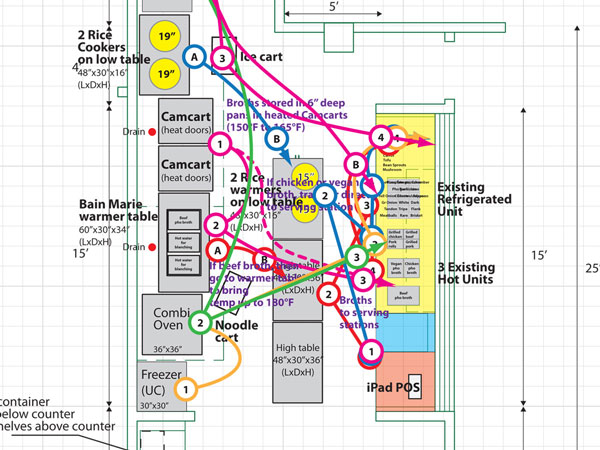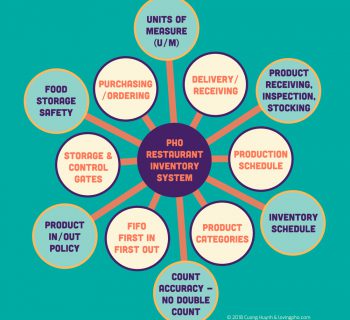 Updated 06-26-17. Opening your pho restaurant is not unlike opening any other restaurant. Everything starts with a floor plan.
Updated 06-26-17. Opening your pho restaurant is not unlike opening any other restaurant. Everything starts with a floor plan.
Your pho restaurant floor plan is what shows your concept and how you intend to operate your business. It's a big part of your plan submission to city and health authorities of the city you'll be doing business in. It's also the first tool you'll use to discuss with your general contractor to build out the space for you. And it's also an important tool as you manage your team (from your architect, to your general contractor to your employees during training) in preparation leading up to your grand opening.
But not all floor plans are created equal. Let's discuss what a good pho restaurant floor plan is.
What Is a Floor Plan
This question has a straightforward answer. Your restaurant floor plan is a drawing that shows your front of the house and back of the house, and everything in between. It includes equipment and their placements; mechanical, electrical and plumbing locations; and dining room placement of tables, chairs and lightings, among many other things.
To many people, it's very easy to create a floor plan. To others, it's not. But whether you draw up the floor plan yourself or have your architect do it for you, it is important to understand that your floor plan is not just a collection of equipment placed to fill up your space. Beside the fact that the floor plan is the blueprint for your space buildout, it is a critical tool in training your employees and ensuring efficient operation as well.
Okay, all this is easy enough, so what's the point? Here's the real purpose of a good pho restaurant floor plan.
 The Hidden Secret of a Floor Plan
The Hidden Secret of a Floor Plan
A good, solid floor plan for a successful restaurant has a secret: it's much more than what's shown on the surface.
A trained professional can look at a floor plan and tell whether it's a good or not so good plan; or what's wrong with it. For someone with no experience, it's just a collection of drawings of equipment arranged in a given space, maybe for some good reason but not sure what. When designed and executed correctly, the floor plan can be a secret weapon. This is why many restaurant floor plans are kept as company confidential information at least throughout the buildout period, while others forbid photos of the back of the house (BOH) to ever get out to the public.
If an owner knows what she wants to do with her restaurant, then it will show on the floor plan.
If an owner knows how she wants to train her employees, then it will show on the floor plan.
If an owner knows how to ensure a safe workplace, control labor and inventory costs, encourage efficient employee operation and teamwork, give customers great service, and maintain or even improve food quality, then it will all show on the floor plan too.
The fact is, many new restaurant operators rush quickly through the floor plan development process. They can't wait to get to buying and installing stuff: the purchasing of equipment, the building out of the space, the installation of front and back of the house, the design of the walls and dining room, the colors, the tiles, the lights, the signs, etc. What they don't realize is much of this can and should be done after a solid floor plan has been created. This is because, if you have a bad floor plan (one that does not facilitate meeting your business goals) then no amount of tiling or painting or lighting will help.
And therein lies the real secret: the operation itself.
Actually, it's all about the operation, or more accurately, the operation's process/procedures. Allow me to explain.
In a successful business, however you look at it, everything boils down to 2 things:
- Equipment and resources,
- Processes and procedures.
Examples of equipment and resources are the ovens, the pans, the tools, the racks, the shelves, the utensils and even the people that are required to run the business. These are the tangible things that you can see and touch and physically move around.
On the other hand, processes and procedures are the unseen threads that link together the equipment and resources, and directly guide them in a coordinated way. You can't see processes and procedures unless you put your resources in coordinated action. It's the effectiveness of processes and procedures together with smart uses of equipment and resources that will determine the restaurant's profitability.
Put in another way, processes and procedures are the rules, the policies, and the steps that ensure food ingredients, equipment and employees all work together to serve your customers. Processes and procedures are the threads that tie your operation together.
Here's an important note: You cannot run your restaurant with top-of-the-line equipment and mediocre or non-existent processes, but you can definitely run your restaurant with only so-so equipment and great processes and procedures. Think about it.
 By my own estimate, a successful restaurant depends less than 50 percent on good equipment and more than 50 percent on processes and procedures. For this reason, a pho restaurant floor plan is not just about placement of equipment and other assets within your available space. Rather a good floor plan should reflect how the business will and should be run. It is the vision of the restaurant operator translated into a plan that the rest of the team must follow, from the design and buildout before you open to operation after you open. Without this, the plan won't be followed, the business won't be operated as designed and intended, and failure will be the unfortunate result.
By my own estimate, a successful restaurant depends less than 50 percent on good equipment and more than 50 percent on processes and procedures. For this reason, a pho restaurant floor plan is not just about placement of equipment and other assets within your available space. Rather a good floor plan should reflect how the business will and should be run. It is the vision of the restaurant operator translated into a plan that the rest of the team must follow, from the design and buildout before you open to operation after you open. Without this, the plan won't be followed, the business won't be operated as designed and intended, and failure will be the unfortunate result.
I have a motto in everything I do. I call it "the speed of going slow" and it has worked for me in numerous occasions. It goes like this: Slow down, work out your operation and procedures, THEN create a floor plan that supports your operation as you plan it to be. Make adjustments as you need to, but this rule has helped me do a lot of things right the first time, saving a lot of time and money in the process. I hope you take advantage of it and make it work for you as well.
Share with us your suggestions or questions in the comments section below.
For help with your pho restaurant, book a one-hour pho restaurant consultation and get your questions answered.





Hello, we are part of a restaurant group in Virginia. Happy Endings Hospitality Group which owns Roll Play Vietnamese Grill. http://www.rollplaygrill.com
How much would you charge to help consult on all the equipment we need for a small Pho restaurant/noodle bar similar to the Nam Nam noodles?
Specifically like this: https://anakjajan.files.wordpress.com/2015/03/dscf0804.jpg
Hi Di Dang: Thanks for your inquiry. I generally do not discuss consultation fees in a public forum or public comment area. If you’d like to discuss specific requirements for your business then please follow this page to book a Free 1/2 hour consultation at a date and time convenient for you.
/free-half-hour-pho-restaurant-consultation
We can discuss all business matters including consultation fee at that time. I look forward to talking with you.
Cuong Huynh